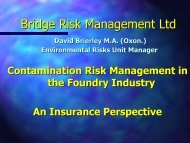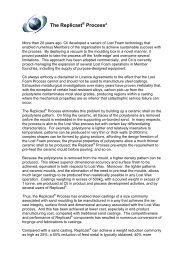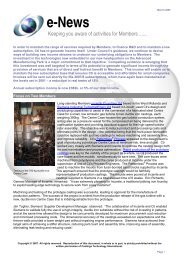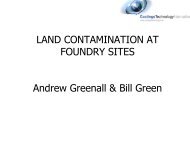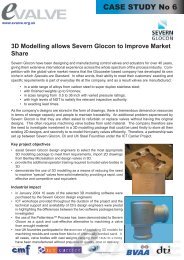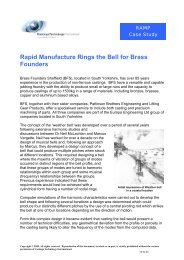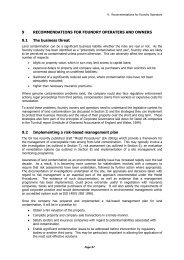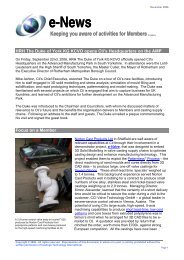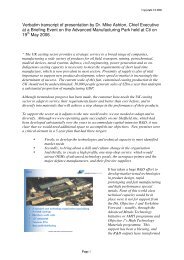Sheffield: Andrew Goddard, Viridor Waste Management - Castings ...
Sheffield: Andrew Goddard, Viridor Waste Management - Castings ...
Sheffield: Andrew Goddard, Viridor Waste Management - Castings ...
Create successful ePaper yourself
Turn your PDF publications into a flip-book with our unique Google optimized e-Paper software.
TREATMENT verses LANDFILL<br />
The implications of landfill<br />
directive<br />
a treatment plant perspective<br />
BY A.GODDARD<br />
1
Summary<br />
1.0 Landfill Directive<br />
1.1 Landfill a Definition<br />
1.2 Article (1) Overall Objective<br />
1.3 Key Dates 1.3A - <strong>Waste</strong> Explicitly Banded<br />
1.3B - Biodegradable Municipal <strong>Waste</strong><br />
2.0 Current Position<br />
2.1 Volumes<br />
2.2 Special <strong>Waste</strong> Analysis 86-99<br />
2.3 Hazardous <strong>Waste</strong> to Landfill 1999<br />
2.4 Treatment Types<br />
2.5 Installed Capacity<br />
2.6 What Will Happen<br />
2.7 Technology Failures<br />
2.8 Hazardous <strong>Waste</strong> Forum - terms of reference<br />
2.9 Hazardous <strong>Waste</strong> Forum - Initial Report<br />
3.0 Key Problems to Overcome<br />
3.1 Immediate Action Required<br />
3.1.1 Regulation - what will happen<br />
3.1.2 Hazardous waste characterisation<br />
3.1.3 Threats<br />
3.2 What should producers do<br />
2
Summary<br />
3.3 What should waste management companies do<br />
3.3.1Capacity Changes<br />
3.3.2 Planning Issues<br />
3.3.3 <strong>Waste</strong> types, Solids, Sludges,Specific problem wastes<br />
3.4 Challenges <strong>Waste</strong> Acceptance Criteria<br />
4.0 Future Issues<br />
5.0 Conclusion<br />
6.0 References<br />
4.1 Proposed New Legislation<br />
4.2 Lessons from France<br />
3
1.1 LANDFILL A DEFINITION<br />
ref 1<br />
• A waste disposal site for the deposit of waste onto or into land,<br />
including:<br />
- Internal sites<br />
- A permanent (more than 1 year) site for temporary<br />
storage of waste<br />
• But excluding:<br />
- Preparation facilities where:-<br />
Storage prior to treatment for<br />
less than 3 years, or<br />
Storage prior to disposal for<br />
less than 1 year<br />
4
1.2 Article 1 Overall Objective<br />
ref 2<br />
• Stringent operational and technical<br />
requirements on waste and landfills.<br />
• To provide for measures, procedures<br />
and guidance to prevent or reduce<br />
negative effects on the environment and<br />
human health.<br />
5
1.3 Landfill Directive Key<br />
Dates<br />
1. A number of wastes cannot be landfilled from July 2002<br />
(Ref. 1)<br />
2. Pre-treatment requirement from July 2004 (Ref. 6).<br />
3. Landfill classifications( All sites should have conditioning<br />
plans)<br />
Inert<br />
Non-hazardous<br />
Stable hazardous<br />
Hazardous<br />
4. Leachability criteria to be applied July 2005.<br />
Tables<br />
What tests (Ref. 3)<br />
5. Other issues<br />
Biogradables in municipal waste economics (Ref. 2)<br />
6
1.3A <strong>Waste</strong>s Explicitly Banned<br />
• Liquid waste<br />
• Explosive, corrosive, oxidising, highly<br />
flammable or flammable<br />
• Infectious waste or unknowns<br />
• any other waste not fulfilling the<br />
acceptance criteria (Annex II (organic<br />
limits, leaching criteria ref 7) - dates to<br />
be confirmed<br />
• Whole types<br />
7
1.3B Biodegradable Municipal<br />
<strong>Waste</strong> ref 1<br />
% of 1995 Date with<br />
value Date derogation<br />
75% 2006 2010<br />
50% 2009 2013<br />
35% 2016 2020<br />
8
2.0 Current Position -<br />
2.1 Volumes ref 4<br />
• 5.2mtpa hazardous waste consigned in 2000 and<br />
rising 8% per annum<br />
• 2.1mtpa of hazardous waste currently being landfilled<br />
in UK<br />
• 1.84mtpa of solid hazardous waste (including<br />
sludges) being landfilled - half of it contaminated soil<br />
• 1.56mtpa is ‘treated’<br />
• 1.0mtpa is recovered/reused<br />
• 156,000 tpa is incinerated<br />
9
2.2 Special <strong>Waste</strong> arising in<br />
England and Wales, 1986/87 to<br />
1998/99 ref 5<br />
10
2.3 1999 Hazardous <strong>Waste</strong> to<br />
Landfill<br />
11
2.4 Treatment Capacity - Types<br />
• Physico-chemical.<br />
• Biological treatment.<br />
• Raw material recovery.<br />
• High temperature incineration.<br />
• Recovery of chemicals e.g. solvents<br />
• Cement fuel.<br />
• Recycling paper, wood, metals, plastics.<br />
12
2.5 Installed Capacity -Ref. 4, 5<br />
• Physico-chemical treatment plants have spare capacity for<br />
over 600,000 tonnes per annum of suitable liquid wastes<br />
• High Temperature Incinerators - very little spare capacity now,<br />
will fill with highest value waste (solids?) post Landfill Directive.<br />
No plans for future capacity<br />
• Cement kiln ‘fuel’ blending - sufficient existing capacity for<br />
clean higher CV liquids and some solids. Though high CV solid<br />
capacity is likely to be filled with shredded tyres.<br />
13
2.6 What Will Happen<br />
• Shortfall in capacity - prices will rise<br />
• More waste will be hazardous and require<br />
treatment - facilities are needed<br />
• Some wastes will require specialist treatment<br />
currently with no technology to solve problem<br />
• <strong>Waste</strong> for landfill will need to be treated to<br />
enable landfill at non-hazardous sites - need<br />
stabilisation/solidification/incineration<br />
14
2.7 Technology Failures<br />
• Wet air oxidation<br />
• Tyre recycling<br />
• Straw burning<br />
• Bioalcohol<br />
15
2.8 Hazardous <strong>Waste</strong> Forum<br />
- Initial Report Findings<br />
• Serious shortfall in landfill capacity<br />
• Landfill HW prices are falling short term<br />
• Some are circumventing the landfill bans<br />
• ca 2mte additional treatment capacity needed<br />
• IPPC waste minimisation impact unknown, but should<br />
reduce amounts produced<br />
• Capacity data needs refining<br />
• Priority wastes - oils, hazardous agricultural,<br />
contaminated soil, asbestos, air pollution control<br />
residues<br />
16
2.8 Hazardous <strong>Waste</strong> Forum<br />
-Terms of Reference<br />
• To advise on the way ahead to achieve HW<br />
reduction and sound management of such<br />
wastes, including advice on key decisions<br />
• To identify opportunities to reduce production<br />
• To consider the impacts of legislation<br />
• To provide a better basis for forward planning<br />
• To ‘ensure’ that the UK has an adequate<br />
network of facilities to handle hazardous<br />
waste<br />
17
3.0 Key Problems to Overcome<br />
3.1 Immediate Action Required<br />
3.1.1 Regulation What Will Happen<br />
• Dates will be changed? - hopefully all to 2005 or 2006, consultation on<br />
changes already carried out<br />
• New categories introduced<br />
– for dedicated landfills relaxation of leachability or anions or<br />
relaxation due to onsite treatment and risk assessment<br />
– possible encapsulated hazardous?<br />
– more salt mine storage?<br />
• More waste will become non-hazardous?<br />
• Get the crystal ball out<br />
• This is a marked contrast to the implementation in France over a 20<br />
year period (Ref. )<br />
18
3.1.2 Hazardous <strong>Waste</strong><br />
Characterisation (Ref. 3,6,10)<br />
• Classification<br />
• Risk phrases<br />
• Hazard codes<br />
• Duty of Care<br />
• Landfill<br />
WASTE SPECIFICATION<br />
Specific Plant:<br />
Procedure Manual:<br />
<strong>Waste</strong> Type:<br />
Appearance:<br />
Process Ongoing:<br />
3468<br />
Physiochemical Treatment (D9) from PPC permitted site BK<br />
Filter Press<br />
OPS/OM05<br />
Filter Press<br />
Brown to Green depending<br />
upon degree of oxidation<br />
Physical Nature:<br />
Solid<br />
EWC: 19 02 06<br />
Quantity:<br />
Hazards<br />
Preservation:<br />
Monitoring:<br />
10,000 – 20,000 tonnes per annum<br />
2002 – reported 12,000<br />
2003 - reported 16,000<br />
In 30m 3 roll on/offs or 8 wheel tipper<br />
nonhazardous<br />
Sealed Containers on Collection (will oxidise in air)<br />
Monthly Spot Samples by COTC holder<br />
Samples from the central region of the plate (no<br />
edges – core)<br />
The plate fills from the bottom up.<br />
Any plate from the press.<br />
<strong>Waste</strong> Characterisation<br />
sawdust – typical<br />
Elemental composition<br />
-Historical Variations<br />
Sludgy(inadequately de-watered) is dried with<br />
characteristics are<br />
-Most recent analysis<br />
-Disposal sites Approval Parkwood, Erin landfill<br />
19
3.1.3 Threats<br />
• Large gap between installed capacity and required capacity to<br />
treat solid hazardous wastes, biggest area of shortfall.<br />
• UK is often late implementing EU legislation<br />
• Lack of clarity in what is expected<br />
• Poor enforcement, especially ‘duty of care’ regulation at<br />
producer sites<br />
• Investors like certainties - producers like the cheapest option<br />
(CAPNIP)<br />
• Planning constraints - long lead times for any new capacity<br />
needing planning permission<br />
May be possible at existing sites, but more difficult due to IPPC<br />
20
3.2 What Should Producers Do<br />
• What should waste producers with hazardous<br />
co-disposal waste streams now do?<br />
- Establish forward strategy dialogue with waste<br />
management company - act early to ‘book’ capacity!<br />
- Identify a UK merchant treatment solution or an endof-pipe<br />
solution post LFD<br />
- No treatment solution visible/acceptable?<br />
Consider possibilities for storage/export of waste, if<br />
appropriate (c.f. fridges), until UK capacity available<br />
• Move to China??<br />
21
3.2 What Should Producers Do<br />
• Producers signing long term contracts<br />
for management of long-life waste<br />
streams is one way of reducing the<br />
investment risk for hazardous waste<br />
management companies<br />
- it will help immensely in bringing in<br />
the required new capacity in the UK<br />
22
3.3 What Should <strong>Waste</strong><br />
<strong>Management</strong> Companies Do?<br />
• Talk to producers direct and not third party<br />
carriers/brokers<br />
• Large gap between existing installed capacity and<br />
required capacity to treat solid hazardous wastes<br />
• Problems in making investment decision<br />
• <strong>Waste</strong> opportunities<br />
Solids<br />
Sludges<br />
23
3.3.1 Capacity Changes<br />
• Expansion / modifications to existing kit e.g.<br />
- Addition of biological treatment plant to existing physicochemical<br />
treatment capacity<br />
- Sludge or fridge handling added at incinerators<br />
- Powder handling facilities<br />
• Lab/pilot trials of the new technologies<br />
- New oxidation methods to scale-up<br />
• Applications delayed awaiting pre-treatment<br />
requirements and implementation dates<br />
• Unfair competition<br />
24
3.3.2 Planning Issues<br />
• If you ‘switch off’ landfill you need to<br />
‘switch on’ something else…<br />
…and that could take some<br />
considerable time and money!<br />
25
3.3.2 Planning Issues<br />
• Plan led system<br />
• Availability and relevance of the <strong>Waste</strong><br />
Local Plans<br />
• Regional development<br />
• Local opposition<br />
• Political will<br />
26
3.3.2 Planning Process<br />
• Typical time scales for a number of<br />
waste treatment facilities (new build)<br />
27
3.3.3 <strong>Waste</strong> Types :Solids<br />
• Contaminated soils make up roughly half of<br />
these. In-situ treatment and some thermal<br />
treatment is available in the UK Needs to<br />
increase.<br />
• Organic chemical solid wastes will need to be<br />
incinerated or entrained into cement kiln ‘fuel’<br />
slurries. Pressure to change acceptance<br />
criteria at kilns to allow high calorific value<br />
solids.<br />
• Inorganic chemical solid wastes will need to<br />
be stabilised prior to landfill<br />
28
3.3.3 <strong>Waste</strong> Types:Sludges<br />
• All sludges a problem post-landfill directive<br />
• Oily sludges - specialised thermal treatment<br />
is probably the best solution for the refineries<br />
• Solidification/stabilisation for inorganic<br />
sludges - non bio cell, or pre-treatment<br />
suitable for salt mine storage<br />
• Incineration or cement kiln ‘fuel’ blending for<br />
organic chemical sludges<br />
29
3.3.3 <strong>Waste</strong> Types :Specific<br />
Problem <strong>Waste</strong>s<br />
• Aqueous liquids with highly toxic organics or Class I + II ground<br />
water contaminants (chlorinated organics or pesticides)<br />
Insufficient incineration capacity for this type of work, other<br />
technology has failed or in development<br />
• Hazardous solids with high levels of anion leach (includes fly<br />
ash residues from incinerators) Even with stabilisation will need<br />
relaxation of anion leach.<br />
• Hazardous solids/sludges e.g. oily sludges with high organic<br />
leach<br />
• Oxidisers in solid form due to high risk of handling and control<br />
• Monolithic wastes with high levels of surface contamination, a<br />
failure to meet metal leachability + anion leach<br />
• Corrosive solids, particularly powders which are dusty<br />
30
3.4 Challenges<br />
<strong>Waste</strong> Acceptance Criteria<br />
• Anion leach sulphate,chloride,fluoride<br />
• Organic leach total too slow a limit on<br />
stabilised hazardous.<br />
• Ecotoxicity needs to be applied to<br />
prevent unsuitable wastes going into<br />
non-hazardous landfill.<br />
• Handling of solids - particularly dusty<br />
corrosive<br />
31
4.0 Future Issues<br />
4.1 Proposed New Legislation<br />
• A number of other pieces of legislation need<br />
implementation or are in progress:-<br />
• Hazardous <strong>Waste</strong> Regulations<br />
• PPC Regulations<br />
• WEEE Directive<br />
• Batteries Directive<br />
• <strong>Waste</strong> Incineration Directive<br />
• Household Hazardous <strong>Waste</strong> Directive<br />
• ELV Directive<br />
• Revision to Licensing Regulations<br />
32
4.2 Lessons from France<br />
• Clear direction - economic instruments<br />
set by government i.e. tax<br />
• Long time scales 10-20 years<br />
• Easier planning/permitting procedures<br />
• Government view of high tech solutions<br />
needs to be defined allowing project<br />
planning. Help in costs of assessing<br />
environmental risk of innovation.<br />
33
5.0 Conclusions<br />
• The management of hazardous waste in the UK is set to change<br />
significantly. IN A MESS<br />
• The numerous legislative drivers suggest that volumes may<br />
reduce but the need for treatment will increase<br />
• The planning system must be ‘joined up’ with strategy targets<br />
• The industry needs clarity of legislation and long-term contracts<br />
to reduce investment risks<br />
• Producers need to take ‘duty of care’ seriously and allow<br />
realistic growth of capacity<br />
• Enforcement of ‘duty of care’ and IPPC by regulator<br />
• Use government to set realistic targets and put all systems in<br />
place to allow implementation, learn from EU partners e.g.<br />
lessons from France<br />
34
REFERENCES<br />
1. Landfill(England and Wales)Regulations 2002, available http://www.hmso.gov.uk/si/si2002/20021559.htm<br />
and http://www.defra.gov.uk/corporate/consult/landfill-regs<br />
http://www.europa.eu.int/smartapi/cgi/sga_doc?smartapi!celexapi!prod!CELEXnumdoc&lg=EN&numdoc=31999L0031<br />
&model=guichett<br />
2. Landfill guidance<br />
http://www.environmentagency.gov.uk/netregs/275207/663559/?lang=_e&theme=®ion=&subject=&searchfor=landfill+guidance<br />
www.iema.net/download.php/Kjohnson.pps<br />
3. Leachability requirements<br />
http://www.eareports.com/ea/rdreport.nsf/0/96dd496ff6451f8180256a6c00395173?OpenDocument<br />
http://www.leaching.net<br />
4. Presentation by Gill Weeks of Cleanaway ltd for BRASS on ‘hazardous waste Legislation- An industry perspective’<br />
http://www.brass.cf.ac.uk/Seminar%203%20Gill%20Weekes.ppt<br />
http://www.teesvalley-jsu.gov.uk/dicidauk/conferences/Halton%202002/<strong>Andrew</strong>%20Smedley.pdf<br />
5. Presentation by A.Smedley of Cleanaway ltd on ‘The landfill directive’<br />
6.Landfill pre-treatment requiremehttp://www.environment-agency.gov.uk/commondata/105385/p1484tr.pdf<br />
7.Ground water contamination http://www.hmso.gov.uk/si/si1998/19982746.htm<br />
8.Alternative treatments<br />
http://www.strategy.gov.uk/files/pdf/technologies-landfill.pdf<br />
http://www.defra.gov.uk/environment/waste/hazforum/<br />
35
REFERENCES<br />
9. Sita report of France’s performance in meeting landfill directive<br />
http://www.defra.gov.uk/environment/waste/hazforum/031021/france.pdf<br />
10. Treatment process BAT http://www.environmentagency.gov.uk/yourenv/consultations/582340/?lang=_e&theme=®ion=&subject=&searchfor=ippc+tre<br />
atment<br />
11. Landfill performance http://www.endsreport.com/issue/tables/336010.gif<br />
36



